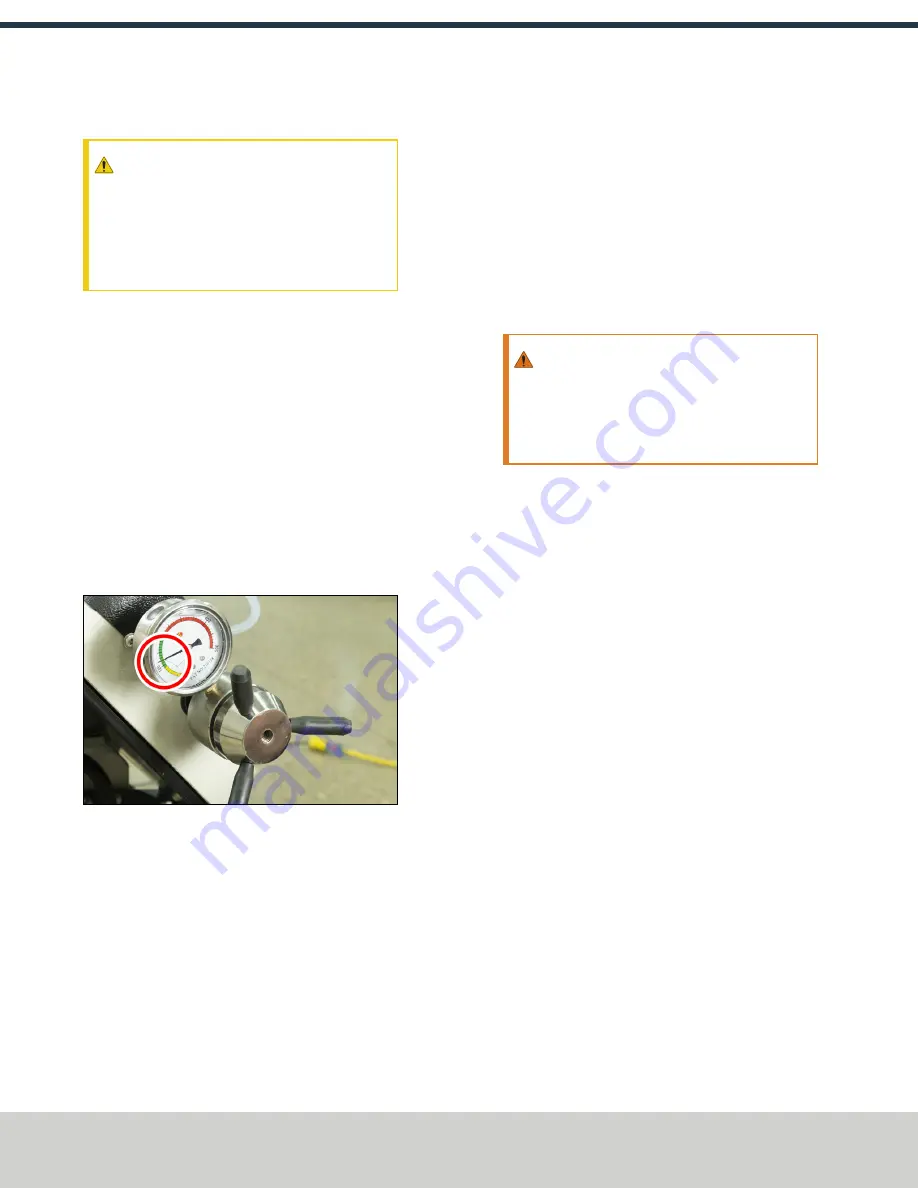
13. Loosen the tensioner to remove the tension on the blade.
CAUTION!
Cut Hazard: Bandsaw blades can cut
you, causing serious injury. Before handling any
bandsaw blades, you must put on work gloves,
eye protection, and any other appropriate
personal protective equipment (like a long-
sleeved shirt and long pants).
14. Carefully remove the blade from the wheels.
15. Put the new blade into the blade guides so that its teeth
are pointing away from the blade guide's rollers, and so
that its tooth direction is pointing toward the motor
(from the blade guides).
16. Use one hand to hold the blade in between the blade
guides, and use the other hand to put the blade around
the wheels.
17. Keep one hand on the blade to hold it in between the
blade guides, and use the other hand to tighten the
tensioner. Continue tightening until the needle on the
blade tensioning gauge is aligned with the tip of the
arrow, as shown in the following image.
Figure 6-9: Tensioner dial aligned with the tip of the
arrow.
18. Close the blade cover, and then secure it using the two
screws you set aside in Step 10.
19. Move the bottom of the blade cover down, and tighten
its two screws.
Before you put the saw head down, you must verify that
the blade is seated.
6.2.2 Verify the Blade Installation
1. Power on the bandsaw.
a. Rotate the Emergency Stop button on the operator
panel one-quarter turn clockwise to release it.
b. Turn the Main Disconnect switch to
ON
.
Mains power is connected to the machine.
2. Set the bandsaw to manual mode: from the control
panel, push the Down Arrow and Up Arrow buttons at
the same time. The control board displays
---
.
WARNING!
Crush Hazard: Moving parts can
entangle, pinch, or cut you, causing death or
serious injury. While operating the machine in
vertical position, you must keep your hands
away from the blade.
3. From the operator panel, push the Cycle Start button.
The blade moves through the blade guides and around
the blade wheels.
4. Let the blade move for three seconds. Then, on the
operator panel, press the Emergency Stop button.
5. Examine the position of the blade on the wheels, and do
one of the following:
l
Blade Correctly Positioned on the Wheels
Go to
Step 6.
l
Blade Moved off the Wheels
Power off the
machine and disconnect it from the power supply.
Then, adjust the blade until it's correctly positioned
on the wheels, and repeat Steps 1 through 5.
6. Carefully set the saw head down.
7. Find the air cylinder and it's bolt that you set aside
earlier. Then, attach the air cylinder back on the
bandsaw.
8. Find the quick-release pin that you set aside earlier.
Then, put it through the air cylinder and into the base
casting.
6.2.3 Break in the Blade
All new bandsaw blades are manufactured with extremely
sharp teeth, which need to be worn down slightly so that they
don’t fracture under the high cutting pressure used in
bandsawing. Your blade will cut more consistently and last
©Tormach® 2020
Specifications subject to change without notice.
Page 30
UM10538: Tormach AF50 Autofeed Bandsaw (Version 0320A)
For the most recent version, see tormach.com/support
6: BASIC OPERATIONS






























